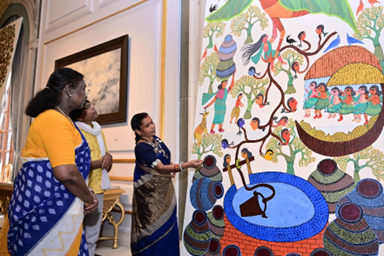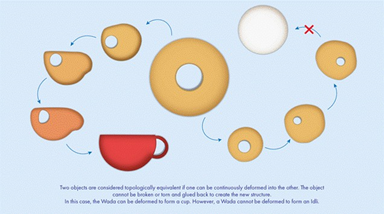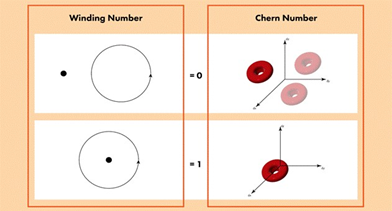TOPIC-1: Madhubani and Gond Art
GS-1: Art and Culture
The context: On 26th May 2025, a group of traditional artists called on the President of India as part of the Artists-in-Residence programme being held at Rashtrapati Bhavan. The traditional art forms of India are being showcased in Artists in Residence programme – Kala Utsav in their original forms. This Kala Utsav has provided a platform to the folk, tribal and traditional artists of India at Rashtrapati Bhavan who have continued the varied forms of art since generations.
-
- The artists of Gond art of Madhya Pradesh and Madhubani art of Bihar are staying at Rashtrapati Bhavan from May 20 to 27, 2025 under the Artists-in-Residence programme.
About Madhubani Art (Mithila Art):
-
- It originates from the Mithila region of Bihar; also referred to as Mithila painting.
-
-
- A folk-art form traditionally created by women on walls and floors of huts during auspicious occasions.
- Now practiced on cloth, canvas, and handmade paper.
-
-
-
Key Features
-
-
-
- Natural Materials: Uses plant-based pigments, cow dung-treated paper, and bamboo pens.
- Bold Outlines: Black lines made with cow dung and charcoal; filled with vibrant natural colors.
-
Themes:
- Religious: Depictions of Hindu deities like Radha-Krishna, Shiva, Saraswati, etc.
- Social: Scenes from village life, weddings, and festivals.
- Nature: Birds, animals, trees (Tulsi, Banyan), sun, and moon.
- Cultural Identity: Symbol of female creativity and rural tradition passed down through generations.
-
About Gond Art:
-
- It is practiced by Pardhan Gond tribes of Madhya Pradesh and adjoining Central Indian states.
-
-
- Tribal art form with roots in oral storytelling and ritualistic practices.
- Initially drawn on walls of homes to depict folk tales and nature.
-
-
-
Key Features:
-
-
-
- Mythical Narratives: Depicts divine stories, village folklore, and animist beliefs.
- Pattern Work: Fills motifs with fine dots and lines to create visual rhythm.
- Nature Connection: Harmonious coexistence of humans, flora, and fauna.
- Colour Use: Bright, bold colour schemes with creative compositions.
- Global Reach: Popularized internationally through works like “The Night Life of Trees” by Tara Books.
-

Source: PIB
Topic- 2: Panchayat Advancement Index (PAI) 2.0 Portal
GS- 2: Governance
The context: The two-day National Write shop on Panchayat Advancement Index (PAI) Version 2.0 for FY 2023–24 commenced on 26th May 2025 at Dr. Ambedkar International Centre, New Delhi. During the inaugural, the PAI 2.0 Portal was launched Local Indicator Framework (LIF) Booklet for FY 2023–24 along with the Standard Operating Procedure (SOP) was also released on this occasion.
Key Highlights:
-
- The Ministry of Panchayati Raj emphasized the transformational potential of the Panchayat Advancement Index (PAI) in enabling Panchayats to systematically assess and improve performance across key areas of governance and service delivery.
- The PAI is not merely a data collection tool, but a mechanism to institutionalize transparent, accountable, and performance-based Panchayat-level governance.
- The PAI Portal 2.0 will offer a comprehensive view for the holistic development of India. PAI data is regarded as the foundation for equitable development, transparency, and participatory governance.
- The Ministry urged all Gram Panchayats to prominently display their PAI scorecards at GP Bhawans to enhance public participation and local accountability.
- The Ministry is committed to building a robust evidence-based platform aligned with the Sustainable Development Goals (SDGs).
- Over the last five years, India’s SDG data availability has improved significantly, rising from 55% to nearly 95%, highlighting improved data coverage and governance tracking.
- PAI 2.0 embodies the philosophy of “Measure what we treasure and treasure what we measure,” underlining the importance of data-led decision-making in rural development.
- The PAI framework, through improved standardisation, harmonisation, and visualisation, promotes inclusive and outcome-oriented governance.
- PAI is envisioned to serve as the foundation for achieving the goal of Viksit Bharat through the “Sabka Prayas” (everyone’s effort) approach, supporting bottom-up, participatory development and providing a benchmark for tracking India’s progress across multiple development indicators.
About Panchayat Advancement Index (PAI) 2.0 Portal :
-
- PAI is a multidimensional assessment framework developed by the Ministry of Panchayati Raj to enable performance tracking of over 2.5 lakh Gram Panchayats across nine themes aligned with the Localization of Sustainable Development Goals (LSDGs).
- PAI 2.0 is a powerful bridge connecting local efforts to national and global commitments.
- PAI 2.0 equips Panchayats with practical tools to assess their own progress, identify gaps, and plan meaningfully.
- It encourages a culture of healthy competition and continuous improvement.
- While PAI Version 1.0 served as the baseline and covered data from 2.16 lakh Gram Panchayats across 29 States/UTs, PAI Version 2.0 represents a major leap forward in functionality, efficiency, and usability.
- The transition from PAI 1.0 to 2.0 reflects a focused refinement of the framework, with a sharper and more practical set of indicators and data points to improve usability and reliability, while retaining thematic comprehensiveness.
Comparison of PAI 1.0 and PAI 2.0:

Source: PIB
Topic- 3: New code for detecting hidden properties of exotic materials
GS-3: Science and Technology
The context: Recently, scientists have found a new way of spotting a property of topological space called topological invariant in quantum materials, that remains unchanged under continuous deformations or transformations.
Scientific New Discovery on “understanding of Topological Equivalence”:
-
- Topological materials are at the forefront of next-generation technology—quantum computing, fault-tolerant electronics, and energy-efficient systems. However, detecting their exotic properties has always been challenging.
- Topological invariance implies that if you can deform one shape into another without cutting or gluing, any topological invariant will remain the same. Example: A popular analogy is the wada (or a donut) and a coffee cup. Since both have one hole, they are topologically equivalent.
- In certain materials like topological insulators and superconductors, strange things happen.
- Electrons behave differently depending on how the material is “shaped” at the quantum level.
- These “shapes” are defined not by appearance but by deeper properties—topological invariants, such as winding numbers (in 1D systems) and Chern numbers (in 2D systems).
- These numbers act as hidden codes that determine how particles move through a material.

-
- A team from the Raman Research Institute, an autonomous institute under the Department of Science and Technology, has discovered a new way to detect this hidden code using a property called the spectral function.
- This spectral function acts like a quantum fingerprint that reveals how energy and particles behave inside the material.
- Traditionally, scientists used techniques like ARPES (Angle-Resolved Photoemission Spectroscopy) to study electron behaviour.
- The new research, published in Physical Review B, demonstrated that the spectral function itself holds clues to the material’s hidden topology—a revolutionary method to “see” the structure without direct observation.

-
- The spectral function has long been used as an experimental tool to probe density of states and the dispersion relation of electrons through ARPES.
- However, it was not previously recognized as a tool to explore topology or topological aspects of electronic systems.
- This study potentially provides a universal tool to explore and classify topological materials, paving the way for new discoveries in condensed matter physics—with promising implications for quantum computers, next-gen electronics, and energy-efficiency.
Source: PIB
Spread the Word
